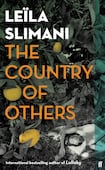
The Franco-Moroccan author Leïla Slimani has made a name for herself writing searing novels about the experiences of women in the home and workplace. Her debut, Lullaby, was a chilling and insightful book about a female nanny pushed to the brink. It won the Prix Goncourt in France, with Slimani making history as the first Moroccan woman to receive the award. Her second, Adele, told the story of a Parisian journalist and housewife, a closeted sex addict leading a double life.
Both these books had a vital, of-the-moment quality, which fitted with Slimani’s background as a journalist and frequent commentator on women’s rights. In 2017, French president Emmanuel Macron chose her as his personal representative for the promotion of the French language and culture.
Slimani’s third novel, The Country of Others, goes back in time to a period after the second World War when resistance to French rule was gathering pace in Morocco. The first in a trilogy that will cover 1946-2016, the novel is partly inspired by the author’s family history. The plot sees a young woman from Alsace, Mathilde, fall in love with a Moroccan solider serving in France during the second World War. When the war ends, she follows him home to Rabat to begin a new and very different life.
Historical approach
The book’s chief success is its depiction of the historical context, particularly the clash of Arab and European cultures, which comes to life through the everyday activities of Mathilde and her husband Amine. The couple, and subsequently their “halfblood” children, are distrusted by both the native people and the colonial French.
Life is difficult from the get-go. Mathilde misses the freedom and relative luxury of home. After the romance fades, Amine wants “a wife like his mother, who would understand him instinctively, who shared the patience and abnegation of his people, who spoke less and worked more”.
The hardship of the path they’ve chosen, and indeed the strangeness of it in a land where such unions are widely reviled, is skilfully evoked through atmospheric descriptions. For Mathilde, there is the shock of the landscape, the dust, the heat, the “sky so profoundly blue that it looked as though it had been washed in the sea”. At her first feast of Eid-al-Adha, she remarks that it would be a good day to murder someone: “The smell of raw flesh filled the air and the woolly skins of sheep were hung from iron hooks on front doors.”
Strangest of all is the way she is now a second-class citizen, expected to serve her husband: “She understood she was a foreigner, a woman, a wife, a being at the mercy of others.” Slimani is excellent on female subjugation in Arab culture, as one would expect from an author whose nonfiction has covered this topic extensively.
Realistic details pepper the narrative, from the hierarchies within gender – Amine’s mother is deferential to her white, educated daughter-in-law, but maligns Yasmine, the black “slave” her husband bought at the market in Marrakech – to the treatment of Amine’s beautiful sister Selma by her own brothers, who beat her pre-emptively to ensure she doesn’t stray.
Polyphonic approach
The Country of Others is a sprawling, populous novel, with multiple perspective changes that at times drain the narrative of tension and depth. The polyphonic approach includes the interior worlds of various family members and more peripheral characters. The author tries to give everyone airtime – perhaps a result of its real-life inspiration – and ends up with a book that is less than the sum of its parts.
Scenes begin randomly and finish abruptly. Characters come and go: crafty peasant workers, unfriendly neighbours, a bigoted doctor, Amine’s former lieutenant in the army. All of these scenarios are possibly real but, related in a scrappy, omniscient style, they seem unconvincing in fiction.
Structurally, the biggest problem is with time. The narrative spans 10 years, culminating with Moroccan independence, but in the domestic sphere of the farm, where the action mostly takes place, it can feel as if the couple have been married forever.
Nevertheless, there is much that entertains and informs. The final quarter focuses on the Moroccan revolt and the impact it has on the family. It is cleverly related in snippets that show the growing unrest: the disappearance of Amine’s brother to fight in the war, the increasing fear that the family’s farm will be targeted because of Mathilde’s heritage.
One stunning passage sees a farm labourer warn Mathilde to never open her door to him if he comes at night. Such small moments bring history to life: “Even if I tell you it’s an emergency, that someone is sick or needs your help, you must keep your door closed. Warn your children, tell the maid. If I come, it will be to kill you.”











